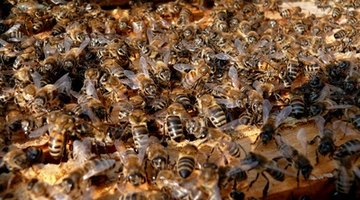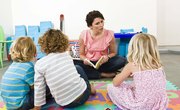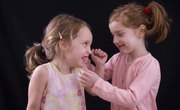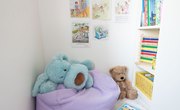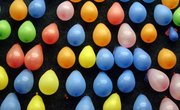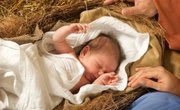Children have varied reactions to bees. Some are fascinated with them, but others are scared about being stung. Activities revolving around bees can help kids realize how amazing these insects are. Plan hands-on activities relating to bees for a comprehensive bee unit. Combine the activities with a variety of trade books about the insects.
Bee Dancing
Bees use dancing-type movements to let other bees know the locations of flowers. Kids can learn the types of movements used by bees and implement them into their own bee dances. Bees use their movements to indicate how far away flowers are. Moving in a circle means they are nearby, while a wagging movement with the abdomen means flowers are far away. To direct other bees to flowers, a bee will move in a straight line, to the left or to the right while wagging its abdomen. Kids can use similar movements to direct their classmates to objects in the classroom. Divide the class into small groups. Each group needs a stack of cards with different classroom objects written on them. One child will pick a card and do a bee dance to show the others where the object is. Other group members will guess the location based on his bee dance.
Musical Flowers
This bee game is a variation on musical chairs. Make several large flower cutouts from poster board. You'll need one less flower than there are kids. Laminate the flowers to make them more durable. Tape the flowers to the floor in different areas of the room. Taping them down will keep them more secure and help prevent kids from slipping. Play music such as "Flight of the Bumblebee" and have the kids buzz around the room like bees. When the music stops, the kids will try to land on a flower. The child who doesn't get to a flower is out of that round. Remove one flower from the floor and play again. To make the game move faster, remove two or three flowers after each round.
Nectar Relay
One bee can hold about enough nectar to fit into an eye dropper on each trip. Use actual eyedroppers in this relay race so kids can see how many trips it would take to make a significant amount of nectar. At one end of a playing field, each team needs a cup of water to represent nectar. Each team also needs a smaller empty cup at the other end. The cup sizes don't matter as long as each team has the same size. The first player on each team will run with an empty eye dropper down to the cup of water. She will fill the eye dropper and run back to the starting line where the empty cup is waiting. She will squeeze the water into the cup and pass the eye dropper to the next person. The first team to fill the collection cup wins the relay.
Honey Taste Test
Before letting kids taste honey, check with their parents to make sure there aren't any allergies. If all of the kids can have honey, bring in a jar for taste testing. Let the kids try the honey on bread. You can also use the honey in a recipe for cookies, bread or other baked goods. Another option is to bring in a honeycomb for the kids to inspect and try. Look for a honeycomb at a specialty market or at a honey farm.
Honey Farm Field Trip
A field trip to a honey farm will give kids a firsthand look at how honey is produced and bottled. Contact any honey farms in your area to see whether they offer tours. Letting the kids see the honeycombs in person will give them a one-of-a-kind learning experience.
Related Articles
References
Writer Bio
Based in the Midwest, Shelley Frost has been writing parenting and education articles since 2007. Her experience comes from teaching, tutoring and managing educational after school programs. Frost worked in insurance and software testing before becoming a writer. She holds a Bachelor of Arts in elementary education with a reading endorsement.

